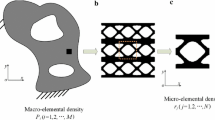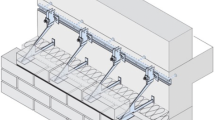Abstract
Toexplore weight saving potential capability, a multidisciplinary optimization procedure based on simulated annealing algorithm was proposed to unveil the minimum weight design for integrated thermal protection system subjected to in-service thermal and mechanical loads. The panel configurations with one-layer and two-layer corrugated cores are considered for comparison. Heat transfer and structural field analysis for each panel configuration were performed to obtain the temperature, buckling, stress and deflection responses for structural components of interest, which were then considered as critical constraints of the optimization problem. Sensitivity analysis was performed to disclose the effect of individual design variables on the thermo-structural extreme responses, and the designed thermal protection system performance and weight for the two configurations were discussed. The results demonstrated that the two-layer structure provides superior structural efficiency and performance to resist thermal buckling deformation in comparison with the one-layer panel. Its area-specific weight is reduced by more than 14–29 % with respect to the one-layer panel design, and 30–50 % weight efficient can be implemented at higher thermal buckling constraint levels, while keeping considerable temperature, stress and deflection margins.





Similar content being viewed by others
References
Alrefaei M H, Diabat A H (2009) A simulated annealing technique for multi-objective simulation optimization. Appl Math Comput 215:3029–3035
Aryanezhad M B, Hemati M. (2008) A new genetic algorithm for solving nonconvex nonlinear programming problems. Appl Math Comput 199:186–194
Bapanapalli SK, Martinez OM, Gogu C, Sankar BV, Haftka RT (2006) Analysis and design of corrugated-core sandwich panels for thermal protection systems of space vehicles. 47th AIAA/ASME/ASCE/AHS/ASC Structures, structural dynamics, and materials conference AIAA 1942
Bapanapalli S K (2007) Design of an integrated thermal protection system for future space vehicles. Ph.D. dissertation. University of Florida
Clarke S, Griebsch J H, Simpson L T (2005) Analysis of support vector regression for approximation of complex engineering analyses. Transactions of ASME, Journal of Mechanical Design 127 (9):1077–1087
Daxner T, Flatscher T, Rammerstorfer FG (2007) Optimum design of corrugated board under buckling constraints. In: 7th world congress on structural and multidisciplinary optimization COEX Seoul
Erdal O, Sonmez F O (2005) Optimum design of composite laminates for maximum buckling load capacity using simulated annealing. Compos Struct 71:45–52
Gogu C, Bapanapalli S K, Haftka R T, Sankar B V (2009) Comparison of materials for an integrated thermal protection system for spacecraft reentry. J Spacecr Rocket 46 (3):501–513
Harlod S Z U, Hartley R (1987) Fast simulated annealing. Phys Lett (A) 122 (3,4):157–162
Hastie T, Tibshirani R, Friedman J (2001) The elements of statistical learning: data mining, inference, and prediction. Springer
Khalkhali A, Asadi H, Gorji M, Ashouri. D (2007) Modeling and optimization of sandwich panels with corrugated cores. In: 3rd WSEAS international conference on applied and theoretical mechanics:60–66
Kirkpatrick S, Gelatt C D, Vecchi M P (1983) Optimization by Simulated Annealing. Science 220:671–680
Kumar S, Villanueva D, Sankar BV, Haftka RT (2008) Probabilistic optimization of integrated thermal protection system. 12th AIAA/ISSMO multidisciplinary analysis and optimization conference AIAA 5928
Liang C C, Yang M F, Wu P W (2001) Optimum design of metallic corrugated core sandwich panels subjected to blast loads. Ocean Eng 28:825–861
Lombardi M, Hafta RT, Cinquini C (1992) Optimization of composite plates for bukling by simulated annealing. AIAA-92-2313-CP
Mageras GS, Mohan R (1993) Application of fast simulated annealing to optimization of conformal radiation treatments. Med Phys 20 (3):639647
Martin JD, Simpson TW (2005) Use of kriging models to approximate deterministic computer models. AIAA J 43 (7):853–863
Martinez O. (2007) Micromechanical analysis and design of an integrated protection system for future space vehicles. Ph.D. dissertation. University of Florida
Metropolis N, Rosenbluth A, Rosenbluth M, Teller A, Teller E. (1953) Equation of state calculations by fast computing machines. J Chem Phys 21:1087–092
Miller I, Freund J E, Johnson R A (1965) Probability and statistics for engineers, vol 4. Prentice-Hall, Englewood Cliffs, p 432
Myers R H, Montgomery DC (1995) Response surface methodology: process and product optimization using designed experiments. John Wiley, New York
Olamaei J, Niknam T, Gharehpetian G (2008) Application of particle swarm optimization for distribution feeder reconfiguration considering distributed generators Applied. Math Comput 201:575–586
Pichona T, Barreteau R, Soyris P, Foucault A, Parenteau J M, Prel Y, Guedron S. CMC (2009) thermal protection system for future reusable launch vehicles: Generic shingle technological maturation and tests. Acta Astronautica 165176:65
Poteet C C, Hasan A K, Hsu S Y (2004) Preliminary thermal-mechanical sizing of a metallic thermal protection system. J Spacecr Rocket 41 (2):173–182
Ravishankar B, Sankar BV, Haftka RT (2011) Uncertainty analysis of integrated thermal protection system with rigid insulation bars. 52nd AIAA/ASME/ASCE/AHS/ASC structures, structural dynamics and materials conferenc AIAA 1767
Sharma A, Gogu C, Martinez OA, Sankar BV, Haftka RT (2008) Multi-fidelity design of an integrated thermal protection system for spacecraft reentry. 49th AIAA/ASME/ASCE/AHS/ASC structures, structural dynamics, and materials conference AIAA 2062
Savsani V, Rao R V, Vakharia D P (2010) Optimal weight design of a gear train using particle swarm optimization and simulated annealing algorithms. Mech Mach Theory 45:531–541
Shi Y, Eberhart R (1998) A modified particle swarm optimizer. International Conference Evolutionary Computation:69–73
Shieh H L, Kuo C C, Chiang C M (2011) Modified particle swarm optimization algorithm with simulated annealing behavior and its numerical verification. Appl Math Comput 218:4365–4383
Tian Y S, Lu T J (2005) Optimal design of compression corrugated panels. Thin-Walled Struct 43:477–498
Villanueva D, Haftka RT, Sankar BV (2010) Including future tests in the design of an integrated thermal protection system. 51st AIAA/ASME/ASCE/AHS/ASC structures, structural dynamics, and materials conference AIAA 2597
Vinson JR (1987) Minimum weight web-core sandwich panels subjected to combined uniaxial compression and in-plane shear loads. AIAA/ASME/ASCE/AHS 28 th structures. Structural Dynamics and Material Conference 0768:282–288
Vinson J R, Shore S (1971) Minimum weight web core sandwich panels subjected to uniaxial compression. AIAA J Aircr 8:843–847
Wang L, Zheng DZ (2000) Simulated Annealing with the State Generator Based on Cauchy and Gaussian Distributions. J Tsinghua Univ (Sci Tech) 40 (9):109–112
Xu SL (2004) C algorithms commonly used procedures set, 3rd edn. Tsinghua University Press, pp 351–363
Acknowledgments
This work was supported by National Natural Science Foundation of China (Grant No. 11102054 and No. 51301 053), supported by Postdoctoral Science-research Developmental Foundation of Heilongjiang Province (Grant No. LBH-Q12101), supported by Fundamental Research Funds for the Central Universities (Grant No. HIT. NSRIF. 2014026).
Author information
Authors and Affiliations
Corresponding author
Appendices
Appendix A: Heat transfer models of ITPS (Bapanapalli et al. 2006)
The ITPS panel is subject to an incident heat flux. Re-radiation condition is applied on the top surface with an emissivity of 0.8. Convective heat loss is also applied on the top surface, after aerodynamic heating is ceased. The bottom surface is assumed to be conservative adiabatic boundary condition. It is also assumed that there is no thermal contact resistance at the interface between the face sheets (and webs) and the insulation materials. The properties of the sandwich core are calculated using the rule of mixtures formula given below:
where C for specific heat, k for conductivity, θ for the corrugation angle. The subscripts C and W represent the homogenized core and structural web material.
The heat transfer problem is modeled as a one-dimensional thermal analysis. The governing equations and boundary conditions can be written as following.
Heat transfer equation for ITPS:
Initial condition:
Boundary conditions:
Where T is temperature, τ is time, x is location along the thickness direction, T i is the initial temperature of the panel before atmospheric reentry, ε the emissivity of the top surface, σ is the Stefan-Boltzmann constant, q i (τ) is the heat influx, and h(τ) is the convection coefficient at the top surface. The subscripts T, C, M and B represent the top face sheet, homogenized core, medium sheet and bottom face sheet of the ITPS panel, respectively.
Appendix B: Response surface methodology
The response surface method fits a function to a set of experimentally or numerically evaluated design data points. In this approach, an appropriate polynomial is fitted to a set of data points by least squares method.
For a quadratic response surface approximation, the polynomial is formulated as:
Where β is regression coefficient and X i represents the ith design variables, n is the number of the design variables.
One of the most frequently used parameter to access the quality of the fitted response surface is the coefficient of multiple determination, which measures the fraction of variation in data captured by the response surface. The remaining variation is attributed to random noise. The coefficient of multiple determination R 2 is defined as
Where Y i is the actual value of the response at the design point, \(\widehat {Y_{i} }\)is the predicted value, and \(\overline Y \)is the average value of Y i . If the R value is closer to 1, the polynomial fitted model gives a good fit. More details on the polynomial response surface approximation have been provided in Ref. Poteet et al. (2004).
To evaluate the accuracy of response surface approximation, two data sets and various statistical criteria were used. The design data set includes all data points used in constructing response surface. The test data set contains n t (n t =50 here) randomly selected points\(Y_{i}^{\ast } \). The total root mean square error (RMSE) σof response surface in the design data set is defined as
The percentage total RMSE for the design points, designated as ‘RMSE-D %’, is obtained as the ratio of σ/\(\overline Y \). The root mean square error in the test data (probability calculation) εis given by the expression
The percentage total RMSE for the test points, designated as ‘RMSE-T %’, is obtained as the ratio of ε/\(\overline Y \). If this value is close to zero then the model performs well.
Appendix C: Correlation coefficient method
The correlation coefficient r is given by
Where \(\overline X \) represents the mean value of input variables. The correlation coefficient can be interpreted as the fractional contribution to the uncertainty in the output due to uncertainty in a given input parameter. The magnitude of the correlation coefficient provides a way to rank the importance of the individual physical variables. If the absolute value of correlation coefficient is close to unity, the parameter strongly affects the response. On the other hand, if the correlation coefficient is close to zero, the parameter has little contribution to the response. Evaluating the correlation coefficients can therefore offer good insight into the mechanism of the response.
Rights and permissions
About this article
Cite this article
Zhao, Sy., Li, Jj., Zhang, Cx. et al. Thermo-structural optimization of integrated thermal protection panels with one-layer and two-layer corrugated cores based on simulated annealing algorithm. Struct Multidisc Optim 51, 479–494 (2015). https://doi.org/10.1007/s00158-014-1137-4
Received:
Revised:
Accepted:
Published:
Issue Date:
DOI: https://doi.org/10.1007/s00158-014-1137-4




